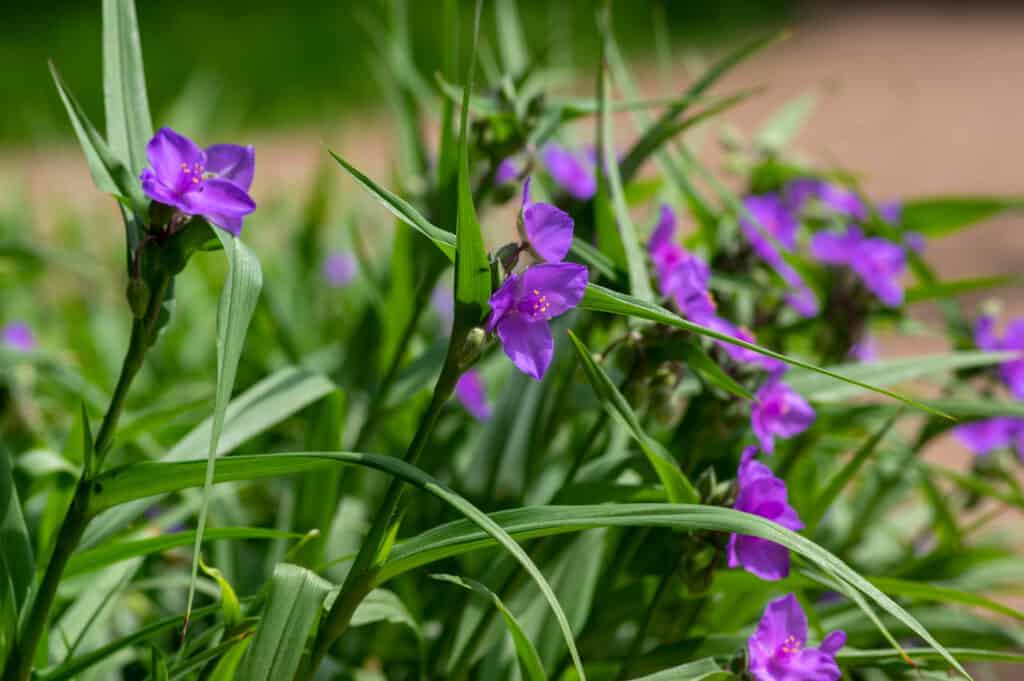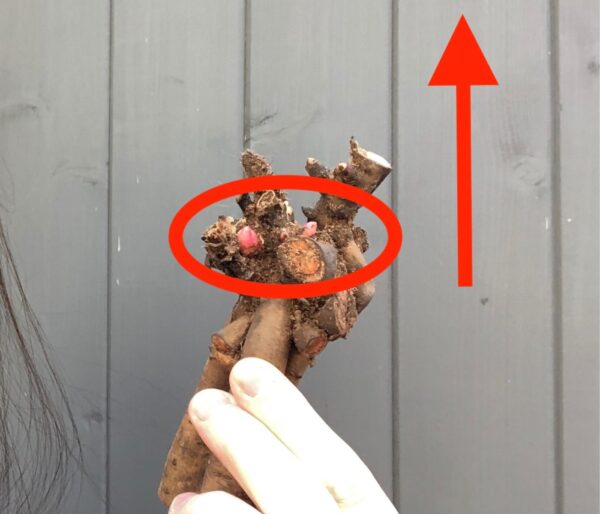Spiderwort is a beautiful flowering plant that is popular and simple to care for. There’s a reason this lovely perennial is in most cottage gardens!
Spiderwort is a flowering herbaceous perennial garden plant grown for its ornamental flowers and thin, long, grass-like leaves. These low-maintenance cottage garden plants thrive in full sun to partial shade, making them versatile in the garden landscape. Spiderwort plants are part of the genus Tradescantia, and typically bloom during the spring and early summertime. Spiderwort plants are native to North America.
Read on to learn all about Spiderwort plants in the outdoor garden!

Spiderwort plants: The basics
Spiderwort Plants are native to the Americas, and can be found in many parts of the United States. These plants are popular because they suffer from very few problems and are easy to grow. The fast-growing plants are great for first-time plant owners. Some popular species include Ohio Spiderwort (Tradescantia ohiensis), Virginia Spiderwort (Tradescantia virginiana), and Woodland Spiderwort (Tradescantia ernestiana).
“Spiderwort” is sometimes used to describe the entire Tradescantia genus of plants, which includes both outdoor herbaceous perennials as well as tropicals grown mainly indoors as houseplants. In North America, “Spiderwort” is generally used in commerce for outdoor garden perennials like Ohio Spiderwort, Virginia Spiderwort, and Woodland Spiderwort. The botanical term “Tradescantia” is more often used on plant labels for tropical Tradescantia houseplants like Inchplant and Moses-In-The-Cradle.
The Spiderwort plant produces grass-like leaves in small clumps. Flowers have three petals and it blooms beautifully in the summertime and produces plenty of flowers. Available colors include blue, purple, pink, and white.
This plant is a fantastic option for your home or garden because of the few problems it suffers from. Some people think the plant name “Spiderwort” came due to the plant hanging down as spiders do from their webs. Other people think the name came because the plant was used to treat spider bites. Still another explanation is that the secretions from broken stems look like spiderwebs when dried.
But regardless of the name’s origin, the Spiderwort plant can be kept in a garden or in a container and be just fine. It is simple for a gardener to move the entire plant without having to worry about the leaves of the plant. If you are lacking garden space, this is a great indoor plant to grow. It can be used as ground cover or as a great addition to light up a room.
People love these plants because of the leaves and many colors it comes in. This grassy plant has leaves that range from smooth textures to hairy textures. The plant colors are great and they produce clusters of flowers on stems every day. Plus multiple colors come in one clump of flowers. This popular plant gives every garden a nice simple look with its light green leaves and grassy appearance.
Spiderwort can bloom year-round outdoors in warm climates. This plant is good because it can grow easily and also be kept under control. It can spread very quickly and will work in most environments. Because of this, these underrated plants can be seen growing naturally near streams, meadows, and woodlands. The plant constantly produces colors so it is never boring to look at. The spiderwort produces healthy foliage and flowers.
Spiderwort varieties: Great cultivars to grow
Here are some beautiful Spiderwort varieties to grow in your garden:
- Amethyst Kiss Spiderwort
- Concord Grape Spiderwort
- Sweet Kate Spiderwort

Growing spiderwort plants
The Spiderwort plant is known as a fast-growing plant that produces beautiful flowers. Needless to say, it may not be very difficult to keep up with maintaining this plant. It is easy to grow in a variety of conditions and is known for growing rapidly without a lot of problems. The plant blooms in the morning and closes up at night.
Depending on the environment, the spiderwort plant can grow from 6 to 36 inches in height and does excellent in crowded flowerbeds. This plant makes a great option for just about any condition. If this plant is in a good environment, it is fast and easy to grow. People love this plant because it is very low maintenance.
Light
One factor that helps improve the growth of a spiderwort plant is light. As the light and heat increase during spring, the plant will begin to produce more flowers. But as stated earlier, the spiderwort plant works well in many different environments. For the spiderwort plant, lighting can be very flexible. The plant can easily adapt to most lighting conditions and it can grow in either sun or shade. But it prefers its light a specific way.
If you are given a choice, place the plant in indirect sunlight. Too much direct sunlight can ruin the leaves of the plant. The spiderwort plant can also tolerate heavy amounts of shade. The spiderwort plant is an excellent plant because it can survive in several conditions. Bright, indirect sunlight is ideal though.
Soil
When it comes to soil, the spiderwort plant is flexible with different soil types. You can grow it in a variety of soils. The most popular soil type is loose soil with drainage. This plant is good because it can also be moved around easily. It is good in most soil conditions and crowded spaces. Although the plant is adaptable to the soil, it must be kept moist. When the soil is kept moist, it will encourage growth during the spring and summer months. It is important to make sure the soil never completely dries out.
Water
The spiderwort plant occasionally needs to be watered. When you water the plant, make sure it is moist, but not too soggy. Use rainwater or distilled water if possible because the spiderwort plant is sensitive to minerals and chemicals in the water. If you overwater your plant, it may cause more damage than good.
To water the plant, check the soil to see how much you need to water it. All plants need to be watered differently depending on the condition it is in. During wintertime, you will not need to water your plant as frequently as the warmer parts of the year.

Caring for a spiderwort plant
Spiderwort plants have simple needs and they do not need a lot of care to keep them looking great. These plants do not need a lot of care because they can tolerate plenty of conditions.
There are a few guidelines for proper plant care. Make sure to fertilize the plant if needed. When your plant is outside, it gets nutrients and minerals from the soil. If your plant is inside, it may need some fertilizer because it is not getting the same nutrients from outside plants.
Indoor plants need a moderate amount of fertilizing. If you do not fertilize your plant enough, it can cause weak growth. If you fertilize your plant too much, it can cause brown leaves. Apply a balanced fertilizer in the spring, and do not overfertilize because it will cause fewer blooms. You may need the adjust the amount of fertilizer based on the plant and conditions.
Cut back the spiderwort plant or trim it when it is needed. A well-trimmed plant creates new growth and great flowers. It can also help provide a fuller look when the vines on the plant are cut back. To do this, make sure you are trimming the flower stalks after each flower starts to die.
Cutting back your plant will help create a tidy and clean look to it and its surroundings. You can use a pair of sharp pruning shears and sanitize them when you are finished trimming. If needed, the entire plant can be cut back to the ground. This way, it will grow fresh and quickly. By the end of summer, the plant will have grown everywhere if it is not cut back on occasion.
Repotting does not have to be done often, but your plant may need to be repotted every 1-2 years. It needs to happen when the large roots are visible or you need to reposition the plant. This gives more room for the roots and the plant to grow. The best time to do this is in the spring. You may need to do this if your plant starts to look dry.
Here is a list of things you will need to repot your plant:
- Make sure to get a bigger pot that has drainage holes in it
- Get a new potting mix. You will need soil and nutrients to help your plant grow
- Scissors or a sharp knife can help cut extra roots
- A trowel or mini shovel will also come in handy for repotting
- Gloves can help keep dirt out of your nails
If you would like to move your plant or divide your plant, it is very simple. First, you need to dig up your plant and cut through the mass root. Then you need to place your plant where you would like in your garden. Make sure to water your plant well and keep an eye on it.
These plants are excellent because they grow quickly and spread easily. The steps to divide the plant and repot it is simple and quick. Overall, these plants are excellent and easy to care for. Although the flowers only last a day, they produce beautiful clusters.









